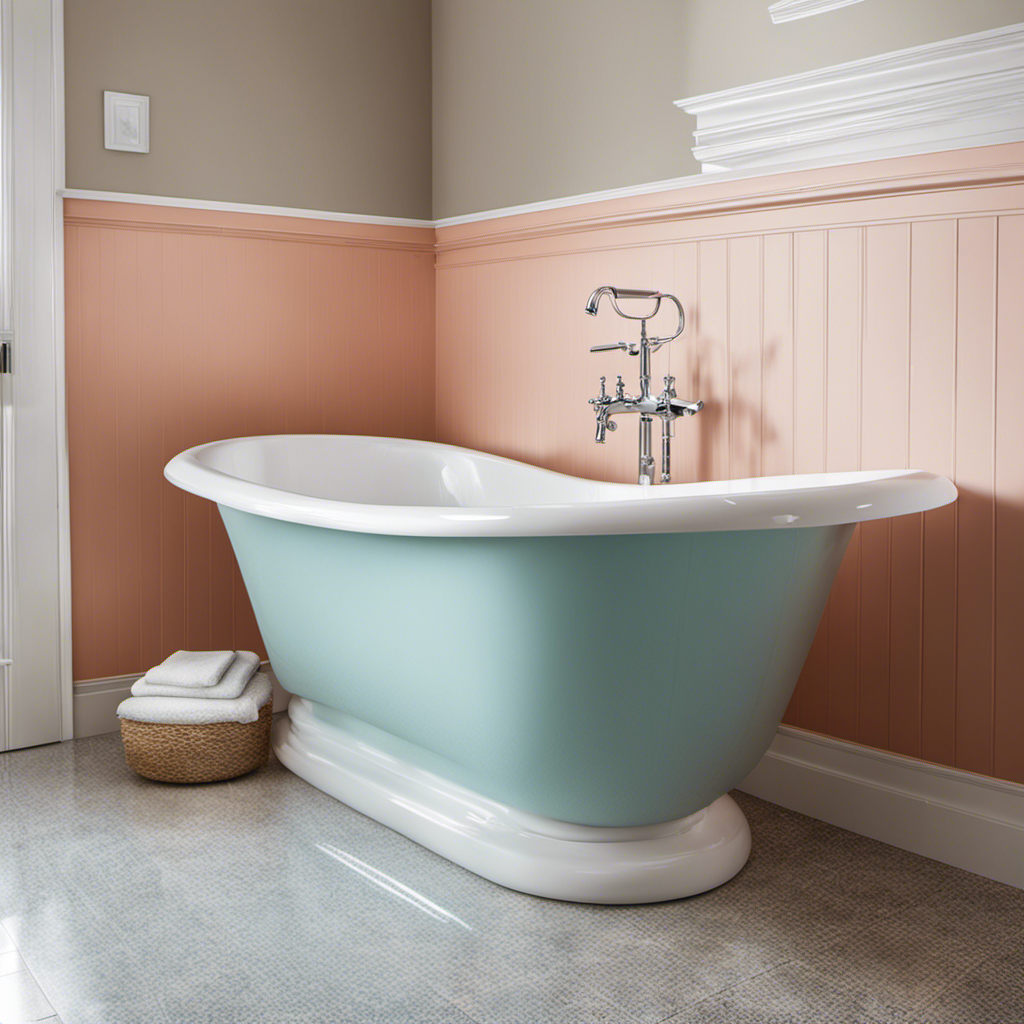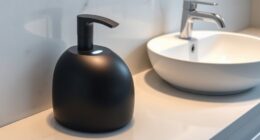Hey there, folks! Ever found yourself ankle-deep in a bathtub filled with stubborn standing water? Trust me, I’ve been there too.
But fear not, because I’ve got the solution for you. In this step-by-step guide, I’ll show you how to unclog your bathtub using simple tools and some clever techniques.
So, grab your plunger and get ready to bid farewell to that frustrating clog!
Key Takeaways
- Remove visible debris or hair near the drain opening before attempting to unclog the bathtub.
- Assess the severity of the clog and determine the appropriate troubleshooting steps.
- Gather necessary tools such as a plunger, drain snake, bucket, and gloves before starting the unclogging process.
- Explore alternative unclogging methods like using baking soda and vinegar, a wire hanger, or a wet/dry vacuum if the plunger method is not effective.
Assess the Severity of the Clog
Now, you’ll want to feel how tight the clog is and determine its severity. This will help you decide on the appropriate troubleshooting steps to take. To assess the severity of the clog, follow these steps:
-
Start by removing any visible debris or hair near the drain opening with your hands or a pair of gloves.
-
Use a flashlight to inspect the drain for any signs of buildup or blockage. Look for things like soap scum, hair clumps, or foreign objects.
-
Try running water down the drain to see how fast it drains. If the water drains slowly or not at all, the clog is likely more severe.
-
If the water doesn’t drain at all, you may need to use a plunger or a drain snake to remove the clog.
Once you have assessed the severity of the clog, you can move on to the next step, which is gathering the necessary tools and materials.
Gather Necessary Tools and Materials
First, you’ll need to gather all the necessary tools and materials for the job. To successfully unclog your bathtub with standing water, you’ll need the following items:
| Tools | Materials |
|---|---|
| Plunger | Baking Soda |
| Drain Snake | Vinegar |
| Bucket | Hot Water |
| Rubber Gloves | Towels |
| Wrench |
Once you have gathered these materials, you can proceed with the unclogging process. Start by removing any visible debris from the drain using your hands or a small tool. Next, pour half a cup of baking soda down the drain, followed by a cup of vinegar. Let this mixture sit for about 30 minutes to break down the clog. Afterward, boil a pot of water and carefully pour it down the drain. Finally, use a plunger or a drain snake to further dislodge the clog if necessary. Remember to wear rubber gloves throughout the process and have towels nearby to clean up any spills.
Remove Any Visible Debris From the Drain
To successfully remove any visible debris from the drain, start by using your hands or a small tool. This step is crucial in unclogging a bathtub with standing water. Here’s how you can do it:
-
First, put on a pair of rubber gloves to protect your hands from any potential hazards and bacteria.
-
Carefully reach into the drain and try to dislodge any visible debris, such as hair or soap scum. Use your fingers to pull it out or a small tool like a drain snake or tweezers.
-
If the clog is severe and you can’t remove the debris easily, it’s important to assess the clog severity before proceeding. This will help you determine if you can handle it on your own or if you need professional assistance.
-
Always remember to take safety precautions when dealing with clogged drains. Avoid using harsh chemicals that may damage your pipes or cause harm to your health.
Use a Plunger to Try and Dislodge the Clog
When it comes to unclogging drains, one of the most commonly used methods is the plunger technique. This technique involves using a plunger to create suction and pressure to dislodge the clog.
However, it is important to understand the effectiveness of this technique and also explore alternative unclogging methods that can be used as backup options.
Plunger Technique Effectiveness
You’ll find that using a plunger is an effective technique to unclog your bathtub with standing water. Here are some tips for using a plunger effectively:
-
Make sure the plunger is the right size for your drain. A small plunger might not create enough suction, while a large one might not fit properly.
-
Fill the tub with enough water to cover the plunger cup. This helps create a seal for better suction.
-
Position the plunger over the drain and push down firmly. Then, pull up quickly to create suction and loosen the clog.
-
Repeat this plunging motion several times, alternating between pushing and pulling, until the water starts to drain.
Using a plunger is a common and reliable method for unclogging a bathtub. However, if it doesn’t work or you prefer to try alternative unclogging methods, there are other options available.
Alternative Unclogging Methods
There are other options available if the plunger doesn’t work or if you prefer to try alternative unclogging methods. Here are some unclogging hacks and DIY remedies that you can try to clear your bathtub drain.
| Method | Materials Needed |
|---|---|
| Baking Soda and Vinegar | 1/2 cup baking soda, 1/2 cup vinegar, boiling water |
| Wire Hanger | Wire hanger, pliers |
| Wet/Dry Vacuum | Wet/dry vacuum cleaner, old towel or cloth |
-
Baking Soda and Vinegar:
- Pour 1/2 cup of baking soda down the drain.
- Follow it with 1/2 cup of vinegar.
- Let the mixture sit for about 30 minutes.
- Flush the drain with boiling water.
-
Wire Hanger:
- Untwist a wire hanger and straighten it out.
- Bend one end into a small hook shape.
- Insert the hook into the drain and start fishing out any clogs.
-
Wet/Dry Vacuum:
- Set the vacuum to liquids mode.
- Cover the vent with an old towel or cloth.
- Place the vacuum hose over the drain and create a tight seal.
- Turn on the vacuum and let it suck out the clog.
Remember to always use caution and follow proper safety procedures when attempting any DIY remedies.
Try Using a Plumbing Snake or Drain Auger
One option to try is using a plumbing snake or drain auger to unclog the bathtub with standing water. Here is a step-by-step guide on how to use a plumbing snake effectively:
- Gather the necessary tools: a plumbing snake or drain auger, gloves, and a bucket.
- Put on the gloves to protect your hands from any debris or dirty water.
- Insert the plumbing snake into the drain, pushing it in as far as possible.
- Rotate the handle of the snake clockwise to break up the clog.
- Slowly pull the snake out of the drain, removing any debris that comes with it.
- Repeat the process until the water starts to drain properly.
- Once the clog is cleared, clean the snake and dispose of any debris in the bucket.
Preventing future clogs:
- Use a drain stopper to catch hair and other debris.
- Regularly clean the drain with a mixture of baking soda and vinegar.
Utilize Natural Remedies or Chemical Drain Cleaners
When it comes to unclogging a bathtub drain, there are two main methods to consider: natural remedies and chemical drain cleaners.
Natural remedies often involve using ingredients like baking soda, vinegar, or hot water to break down the clog.
On the other hand, chemical drain cleaners are designed to dissolve clogs using powerful chemicals.
Before deciding which method to use, it’s important to consider safety precautions and choose the option that best suits your needs.
Natural Vs. Chemical Methods
Using natural methods to unclog a bathtub with standing water is a safer and more eco-friendly option compared to chemical solutions. Chemical drain cleaners may contain toxic ingredients that can harm both humans and the environment.
Natural remedies, on the other hand, utilize household items that are non-toxic and readily available. Here is a step-by-step guide to unclog your bathtub naturally:
-
Baking soda and vinegar method:
- Pour half a cup of baking soda down the drain.
- Follow it with a cup of vinegar.
- Let the mixture sit for about 30 minutes.
- Flush the drain with hot water.
-
Plunger method:
- Place a plunger over the drain and create a seal.
- Push and pull the plunger vigorously to create suction.
- Repeat this motion several times until the water starts to drain.
Safety Considerations and Precautions
To ensure your safety, it is important to take certain precautions when attempting to clear a clogged drain naturally.
When dealing with clogs, it is crucial to handle any chemicals safely and use proper ventilation. First, protect your hands by wearing rubber gloves.
Next, gather the necessary supplies such as a plunger, a drain snake, and a natural drain cleaner like a mixture of baking soda and vinegar.
Before using any chemicals, make sure the area is well-ventilated to avoid inhaling any harmful fumes. If you decide to use a chemical drain cleaner, always follow the instructions carefully and avoid mixing different products.
Consider Calling a Professional Plumber if All Else Fails
If nothing else works, you should definitely consider calling a professional plumber to unclog your bathtub with standing water. Sometimes, the clog can be too stubborn or complex to handle on your own, and it’s best to seek help from a trained expert.
Here are a few reasons why you should consider calling professionals:
-
Experience and expertise: Professional plumbers have the knowledge and experience to diagnose and resolve complex clogs efficiently.
-
Specialized tools and equipment: Plumbers have access to specialized tools and equipment that can effectively remove the clog without causing any further damage to your bathtub or plumbing system.
When to seek help:
-
Persistent clogs: If you’ve tried multiple methods and the clog still persists, it’s time to call a professional plumber.
-
Recurring clogs: If you frequently experience clogs in your bathtub despite your efforts to prevent them, it’s a sign of a deeper issue that requires professional attention.
Conclusion
In conclusion, unclogging a bathtub with standing water can be a daunting task, but with the right tools and techniques, it is possible to restore your drain to its full functionality.
By assessing the severity of the clog, gathering the necessary tools, and using methods such as plunging or using a plumbing snake, you can effectively remove the blockage and get your bathtub draining properly again.
Remember, if all else fails, don’t hesitate to seek the assistance of a professional plumber.
Unclogging a bathtub is like untangling a stubborn knot – with patience and persistence, you’ll be able to conquer the clog and enjoy a smoothly flowing drain.










